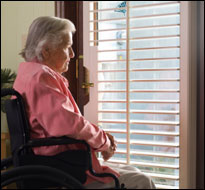
As people advance well past retirement age, their social networks typically begin to shrink; among the factors driving this pattern, their physical mobility becomes limited and many peers move away or die. The health consequences of these changes are substantial. But scientists have not been sure if the primary driver of ill health is the older person’s emotional states — feelings of loneliness and related physiological ailments — or the physical social isolation itself. Prior research has yielded conflicting results.
Social isolation is a growing phenomenon across the Western world: In the United States, the number of people living alone has grown from 17% in 1970 to 28% in 2011, according to the Census Bureau. Similar patterns are being recorded in places such as the United Kingdom. As a 2006 study in the American Sociological Review found, discussion networks shrank dramatically between 1985 and 2004, and the “number of people saying there is no one with whom they discuss important matters nearly tripled.” Humans are, of course, social beings, and in environments of extreme isolation, frequently see a rapid deterioration in health. A 2010 metastudy in PLoS Medicine that analyzed the findings of 148 previous research studies found that, across ages and groups, there was a “50% increased likelihood of survival for participants with stronger social relationships.”
A 2013 study published in the Proceedings of the National Academy of Sciences (PNAS), “Social Isolation, Loneliness and All-cause Mortality in Older Men and Women,” analyzed the cases of 6,500 men and women who participated in the English Longitudinal Study of Aging. The researchers, from University College London, first surveyed the subjects in 2004-2005 and then followed them through 2012, by which time 918 had died. (While the surveys were conducted in the United Kingdom, the frequency of loneliness is similar to that reported in the United States.) Compared to prior studies, the survey sample was large and variables such as preexisting health levels and demographics could be fully accounted for, according to the study’s authors.
The study’s findings include:
- “Both social isolation and loneliness were associated with all-cause mortality; the absolute proportions of deaths were 21.9% vs. 12.3% in the high and low/average isolation groups and 19.2% vs. 13.0% in the high and low/average loneliness groups, respectively.”
- Loneliness itself was not linked with higher mortality rates, and people with high degrees of social isolation were more likely to die, regardless of whether they reported emotional experiences of loneliness. “Loneliness tended to be higher in women and in those from more disadvantaged circumstances…. It is notable that loneliness was more strongly related to baseline poor health than was social isolation, particularly with respect to arthritis, mobility impairment, and depression.”
- Overall, the data indicate that “social isolation is associated with higher mortality in older men and women but indicate that this effect is independent of the emotional experience of loneliness.”
As health policies are being formulated for an aging population across much of the developed world, the research highlights the extent to which social contact itself may be a key public health goal: “Reducing both social isolation and loneliness are important for quality of life and well-being, but efforts to reduce isolation would be likely to have greater benefits in terms of mortality.”
Related research: A 2008 study from Duke and Cornell, “The Ties that Bind Are Fraying,” notes that Americans reported having one-third fewer confidants in 2004 than they did in the mid-1980s. “In 2004 many more people said they don’t discuss matters of importance with anyone,” the researchers write. “And they’ve shifted away from ties formed in the community — at places like church choirs, neighborhood associations, social clubs and sports teams — and toward conversations with family, especially spouses.” These latter concerns have been explored in great detail through research on what scholars call “social capital.”
Tags: aging
